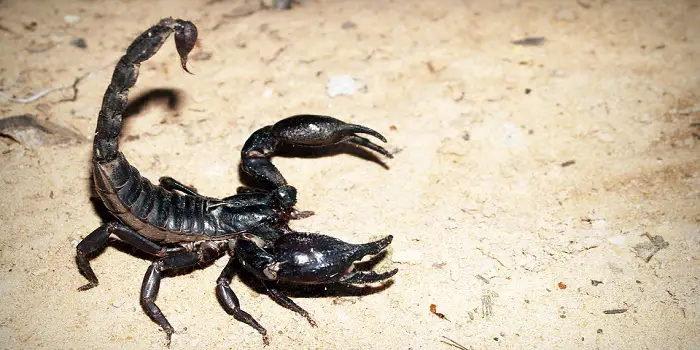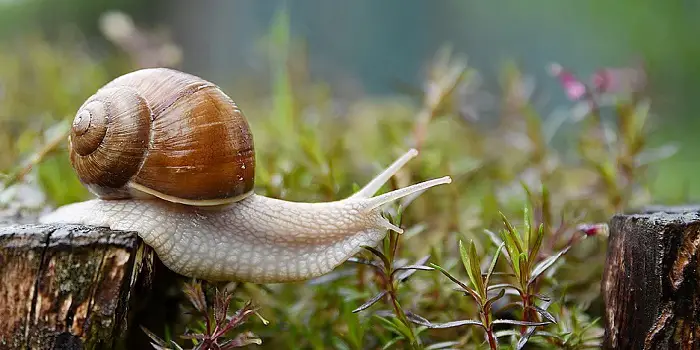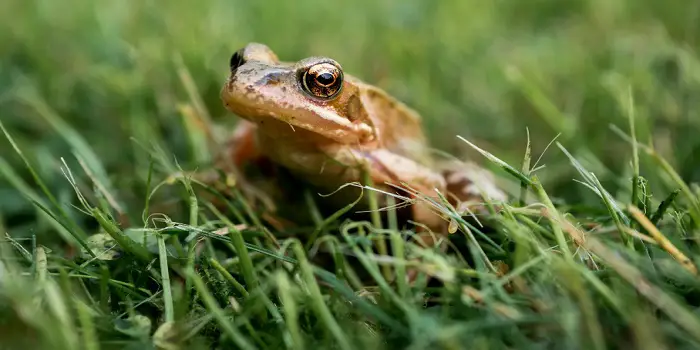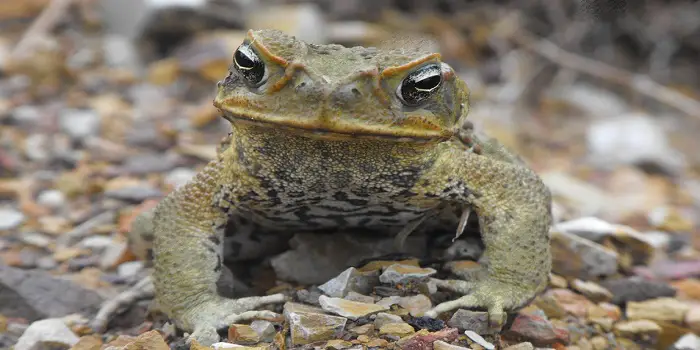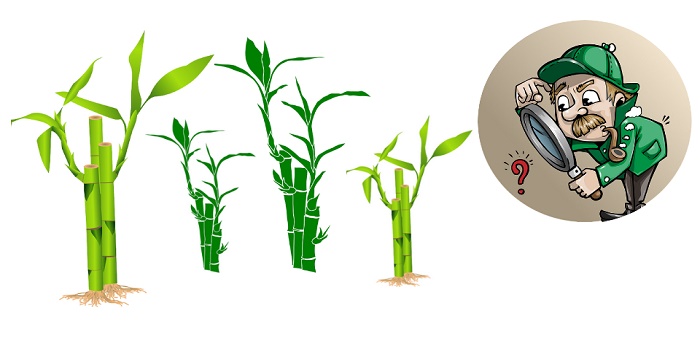
Bamboo has garnered much attention in recent years thanks to its versatility and hardness.
Because it grows quickly and is readily accessible, it has become quite popular as an alternative to wood for flooring, furniture, and more.
Plus, bamboo is not as vulnerable to tropical diseases as many other plants.
However, it is not invulnerable as it is subject to pests, molds, fungus, and rot.
While such conditions are not necessarily fatal to the bamboo, they will need to be caught fairly early in order to be dealt with effectively.
This means that if you are growing bamboo, you will want to monitor it frequently to catch any issues right away.
It does help to know what dangers bamboo will face if you have it in your garden.
Pests That Eat Bamboo
Some insects attack just about any plant, such as aphids.
While others, such as mealybugs, mites, and scales, are exclusive to feasting on bamboo.
As with any plant subject to pests, they become weakened, making the bamboo susceptible to rot and mold.
Plus, there are herbivorous animals that like the taste of bamboo.
Such creatures will leave their mark, so you should be aware of what they are and what they can do.
1- Aphids
Aphids feasts on many different plants and bamboo are no exception.
In addition to causing physical damage, aphids often carry diseases that damage the bamboo even further.
Left unchecked, aphids can wreck your bamboo garden thanks to their incredible reproduction ability.
Aphids are quite small, winged insects that suck out the fluid which keeps your bamboo plant alive.
A plant subject to an aphid attack will appear to wilt and grow slowly.
Worse, aphids secrete a sticky substance that sticks to the bamboo, allowing mold to attach and grow.
While aphids are quite small, they can be seen with the naked eye.
Look for these small flying insects that are usually green but can be brown, yellow, grey, red, tan, or black.
2- Bamboo Mealybug
Like mites and aphids, mealybugs feast on the sap that keeps the bamboo alive and thriving.
In addition, mealybugs leave behind a waste product that is sticky like sap which makes the plant a prime target for rot.
Signs of a mealybug infestation include stems and leaves that are distorted, discolored, and not healthy looking.
While the mealybugs themselves are rather small and pink in color, they are usually covered by a white webbing that is sticky in nature.
If you see what appears to be a fluff of cotton, you can bet that there will be mealybugs underneath.
3- Bamboo Mites
This is arguably the biggest threat to your bamboo.
Mites are quite small, which makes them hard to see.
That means once you see the damage caused by mites, it may be more considerable than is seen from the outside.
Mites can be difficult to get rid of as well.
Mites are often found on the underside of leaves, feasting on chlorophyll.
The first sign that the bamboo may have a mite infestation is a yellowish discoloration of the leaves as they are being drained of their chlorophyll.
If you do not act quickly, the mites will spread around the plant and cause considerable damage.
For bamboo that is grown in North America, particularly in hot and dry areas, mites are a huge concern.
You will need to make a close inspection of the bamboo, starting with the undersides of the leaves.
Mites will appear to be tiny specs located within the fine webbing found in this area.
If you see any signs of mites, act immediately to get rid of them.
4- Scales
These are tiny insects that have shells on their backs.
They suck out the nutrients of the bamboo and cause the plant to quickly deteriorate.
Because of their small size, scale is hard to notice until they clump together in larger colonies along the culm of the plant.
Worse, the scale also produces a honeydew-like substance that attracts even more insects to the plant.
Plus, this substance will also foster the growth of mold.
If you see small, flat cones on the leaves or stems of your bamboo, that is probably a scale.
They tend to be light-colored when young and grow darker as they age.
The damage scale will create on the leaves will appear like irregularly shaped spots that become more numerous as the scale covers the surface.
5- Termites
Termites are a danger to bamboo, just like they are to wood. However, termites will attack the bamboo plant from underneath.
When they emerge from the ground, they will quickly bore into the bamboo and gnaw away from the inside just like wood.
If the colony of termites has multiple queens, they may reproduce into the thousands, which can quickly spread and damage other bamboo plants and anything made of wood that is nearby.
A termite nest is virtually undetectable until they emerge from the ground.
If you see tubes in the mud surrounding the bamboo, that is probably the termites ready to emerge.
Plus, termites can also be winged which means you may see them when they swarm around your bamboo.
There is another type of termite that feasts on dry wood. You will not see mud tubes with these types.
Rather, the nests they create are within the culm parts of the bamboo itself.
By the time they are noticeable, the bamboo is probably heavily damaged by that point.
If you see what appears to be flying ants, that is probably the termites.
Unlike ants, termites have antennae that are straight along with four identically shaped wings. Worker termites have no wings and are small.
6- Animals
Insects are not the only creatures that live and feast on bamboo.
There are several types of animals that also find bamboo quite tasty.
This is because the rhizomes or shoots of the bamboo have a pleasing taste to the following animals.
- Deer
- Gophers
- Squirrels
- Bamboo rats
- Golden monkey
If you live in the tropics, then chimps, gorillas, and elephants also love the taste of bamboo.
Of course, you might not have to worry about the biggest eater of bamboo, which is giant pandas, but there are plenty of other creatures that love this plant.
7- Snakes
While they do not exactly eat it, bamboo does attract snakes like many other bushes or trees.
Particularly if you have bushy bamboo that attracts nesting birds and rodents, then obviously it will also attract the snakes nearby.
Snakes also love to hide in dense bamboo trees, they find here something good to eat and then most likely lay out in the sun while digesting their meal.
8- BaMV
Known as Bamboo Mosaic Potex Virus, this is when humans transmit disease to a plant through the use of dirty or compromised tools.
When cutting or trimming bamboo, tools that are not properly cleaned can transmit BaMV to the bamboo itself.
While quite rare, if BaMV takes hold, there is nothing you can do.
The best advice is to clean your tools before using them for trimming properly.
Signs of BaMV include discoloration of the leaves that has a mosaic pattern.
Next will be the trigs, branches, shoots, and roots starting to die.
9- Black Mold
Sooty in appearance, this form of mold is commonly associated with pests that invade your bamboo.
The secretions of the pests create the grounds for the black mold to grow.
It starts as small black spots that expand over time.
Unless you get rid of the mold quickly, it will destroy the bamboo, mostly thanks to the pests that will be drawn to the area.
10- Fungus and Rot
Certain types of bamboo, particularly indoor bamboo plants in a humid environment, are vulnerable to fungus.
The fungus will appear in circular patterns, which may not be all that harmful to the plant.
However, some types of fungus will cause rot to the roots of the plant along with other issues.
The most dangerous mold will leave behind a noticeable residue, which means that once you see it, you will need to deal with it quickly.
If the soil does not drain properly, then you may see some fungal diseases such as rot occur.
One type is known as Armillaria or oak root fungus, which causes the leaves to drop away and will kill the plant unless treated.
If you notice the bamboo is soft, spongy, or crumbling, that may be a sign of rot as well.
Mushrooms around the base of the plant are also a sign that rot may be taking place.
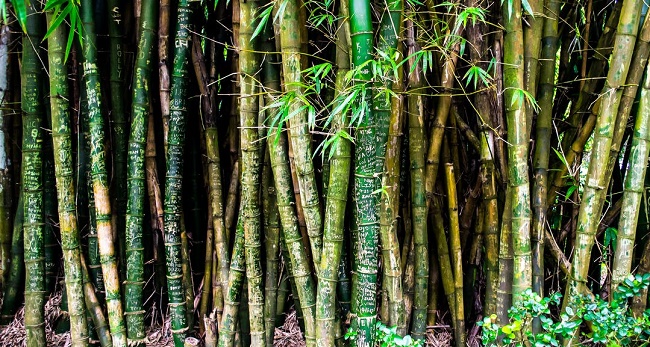
How to Spot Pests on the Bamboo?
Those who are growing bamboo, can take the heart of how hardy the substance is.
This means that if you catch the early signs of pest invasions, you can treat them before they can do real damage.
Some of the signs include the following.
- Brown, wilting, or discolored leaves
- Gnawing, chewing, or biting of the bamboo
- Sticky substance
- White webbing on the underside of leaves
- Circular rings or patterns on the leaves
- Clumps of brownish-grey material
- Noticeable increase of ants or other insects near the plant
Be sure to keep the bamboo properly watered and use nutrients to keep it strong.
You may find that some of the symptoms, such as yellowing or wilting leaves, may be due to a lack of water or nutrients.
By addressing such issues early, you can help keep your bamboo strong and resilient.
How to Get Rid of Bamboo Pests and Diseases?
Bamboo is quite resilient, but it is subject to pests, diseases, mold, and other forms of attack.
The first step in preventing such issues is to keep a healthy garden.
Avoid using harsh chemicals which may create more damage than they cause.
This means that you should avoid using insecticides since they get rid of good insects which are protecting your plants.
There are natural ways to help control pests and diseases that affect bamboo.
What follows are a few tips to keep your bamboo plants healthy while avoiding harsh chemicals or insecticides.
1- Crypts
These are insects that feast on mealybugs.
They look like ladybugs and have the same effect on such pests.
You can order crypts online and once they have destroyed the mealybugs, they will die off as well, causing no other damage.
2- Mowing
If the infestation is large, you may need to mow down the entire area with the bamboo and let it grow again.
Mowing will get rid of most pests because there is nothing left for them to feed on.
Plus, the bamboo grows at three to five feet per year, so it will replenish relatively quickly.
3- Oils
Mix up to five tablespoons of horticultural oils with water and spray across the plants until all the leaves are wet.
This will help prevent an infestation from occurring while not doing any real harm to the bamboo. Just be sure to cover all the leaves with the solution.
4- Predators
There are helpful insects that destroy the dangerous pests to your plants.
Some of the most effective are ladybugs, predatory mites, parasitic wasps, and lacewings which feast on such pests that affect bamboo.
5- Pressure Washing
Using a pressure washer with ordinary water on the base of your bamboo will wash away mites and other insects while doing no harm to the plant.
Focus on the underside of leaves and any dense areas of foliage where mites and insects can gather.
You will need to pressure wash at least a few times a week to prevent the pests from gathering.
Mixing the water with one tablespoon of detergent can increase the likelihood of washing away pests and insects while not harming the bamboo.
Although it may leave the plant somewhat yellow.
Do this once every two weeks to keep down the mite and pest population.
You can also employ physical barriers to the bamboo, which offers some protection.
A good barrier will keep the animals away, which protects the shoots from too much harm.
Once the shoots are hard enough, you can remove the barriers as they will no longer be desirable to consume.
Chemicals that can help
If the infestation has reached a stage where natural methods do not work, then you may have to employ chemical solutions to get the job done.
If you decide to use such materials, be sure to wear the proper safety gear such as eye goggles, gloves, and the like.
Make sure that no chemical comes into contact with your skin.
What follows are some effective chemicals that can rid the pests from bamboo but may also cause some harm to the plant as well.
Abamectin: This focuses on leaf miners and mites, so it leaves other insects and birds alone.
If you have a mite infestation, this may be the best substance to get rid of them.
Imidacloprid Granules: If spraying is not feasible, then you can spread these granules around the plant.
They will get rid of different pests, but you will need to read the instructions on their effect.
Neem Oil: This is an insecticide that can kill different pests such as aphids, mealybugs, mites, whiteflies, and more.
One type of insecticide that is not recommended is malathion.
This is because malathion kills beneficial insects such as bees along with fish and birds. Do not use this substance.
Tips for Preventing Pest Infestations in Bamboo Plants
The best way to get rid of mites and other pests that destroy bamboo is to never let them near it in the first place.
What follows are a few steps you can take to prevent the bamboo from becoming subject to an infestation.
a) Inspection:
All new bamboo plants should be inspected before planting them in your garden.
If you see any signs of infestation, keep the plant away from the rest until it is resolved.
If you are purchasing a bamboo plant, start the inspection process right in the store.
Be sure to bring a magnifying glass with you. And look over the plant carefully.
You’ll want to look at the soil as well to see that it is well-maintained.
And finally, ask if there is a return policy for plants that have been subject to infestation.
b) Wash:
Clean any suspected plants using a high-power or pressure washing system.
This will wash away mites and other insects from the plant.
c) Cut and Remove:
If you see the first signs of a possible disease, you can treat the plant before more damage takes place.
This starts with cutting away the affected areas of the bamboo, such as the leaves and stems.
Any infected roots can be dug up and removed. This can also let the soil dry out properly as well.
Other common conditions include the following.
d) Water:
Until the plant becomes six months old, you will need to water it frequently.
After that point, watering becomes less of an issue.
If the bamboo is still in a pot, keep the soil on the dry side. When you see the leaves start to curl, water the plant.
e) Heat:
Too much heat can damage the bamboo.
So, keep it under the shade or in partially shaded areas to reduce the heat.
f) Soil:
Well-drained soil is a must for bamboo as it helps prevent rot and other diseases.
Good soil quality is key in keeping your bamboo healthy.
A little fertilizer can go a long way.
Even natural fertilizer has salts that may do more harm than good.
Unless there is something specific in the soil that is needed, limit the fertilizer being used.
One final tip is that bamboo can withstand cold weather, so unless the winter is especially cold and long the plant should do fine.
Share the post "What Kind of Pests Live in Bamboo – How to Get Rid of Them?"

Welcome to ProShieldPest.com. I am Tina Jones. I have been working as a pest removal professional in Winslow, Arizona lately. At present, I love to spend my time with my family as a retiree.
Here I share all my knowledge and experiences to help people understand better how they can stop pests at their homes without actually killing them. Hopefully, the information you will find here will help in safeguarding your home! You can check more about me here.

